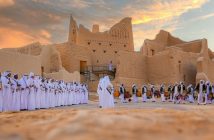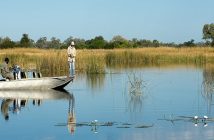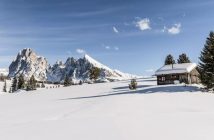“No man can live this life and emerge unchanged. He will carry, however faint, the imprint of the desert, the brand which marks the nomad; and he will have within him the yearning to return,” wrote explorer Sir Wilfred Thesiger in his 1959 tome Arabian Sands, which charts his 1,500-mile journey across the Empty Quarter of the Arabian Peninsula – the least known and most forbidding region of Arabia – between 1945 and 1950. Spanning 250,000 square miles, the Empty Quarter is the largest desert in the world, where, at midday, the sand reaches a blistering 80 degrees.
Born in Ethiopia and schooled at Eton and Oxford, Thesiger was the quintessential English explorer who sought out the secrets of the desert before Arabia was transformed forever when the black gold beneath her sands was discovered. Known affectionately by the Bedouin people as Mubarak bin London (‘the Blessed one of London’), with his sun-scorched skin, prominent Roman nose and wiry black beard, Thesiger comfortably passed as a Bedouin during his desert travels, during which he donned the same attire as the tribesmen.

Surviving on a meagre diet of water and dates, Thesiger believed hardship built character and embraced the extreme conditions he was faced with. “In the desert I had found a freedom unattainable in civilisation. It was very still with the silence which we have driven from our world,” he wrote.
A keen documenter, a series of beautiful black-and-white photos from his perilous voyages across the desert are on display at a permanent exhibition inside the Al Jahili Fort in Al Ain – one of the world’s oldest inhabited settlements and home to several Unesco World Heritage sites. The photos poignantly capture the Bedouin people shortly before their way of life changed for good in the late 1950s when oil was first discovered in Abu Dhabi.
Built in 1891 to protect palm plantations, Al Jahili Fort is a wonderful, whimsical structure that looks like a giant sandcastle. Close by is the Al Ain Oasis, a deliciously shady enclave home to thousands of date palms, mango trees and orange groves that offers a welcome respite from the searing heat of the desert. Abu Dhabi is home to over 120 different types of date, which, like grapes, are harvested once a year, from late September to early December. An Arabian staple, sweet sticky dates are the first thing we’re offered when we arrive at our hotel, along with a cold hand towel and a revitalising glass of hibiscus juice.

Our home for the next four nights is the super swish, recently opened, Saadiyat Rotana Resort & Villas. With a calming colour scheme of tasteful neutrals, the contemporary five-star hotel boasts 327 rooms, 11 villas, seven restaurants, a rooftop bar and its own private beach where you might be lucky enough to spot dolphins darting in and out of the water at sunrise. Underfoot in the hotel’s lobby are rippling sands from the seven Emirates, while rooms are brightened with gazelle paintings by local artist Ashwaq Abdulla. Pin drop quiet at night, awaiting me in my bedroom is a bath big enough to impress Patrick Melrose, and my own monogrammed robe to pad about in.
After an abundant breakfast that involved lashings of tahini-laced hummus and smoky baba ganoush, I head to the spa to be pummelled with pink Himalayan salt stones. Said to boast all manner of heath-boosting properties, from easing inflammation to improving circulation, opting for a hot stone massage in 35-degree heat may not have been the wisest decision I’ve ever made. The smooth pink stones felt like hot potatoes on my back, but the masseur soon soothed me into a soporific state of submission.

The humid heat in Abu Dhabi takes some getting used to. Stepping out of the airport in the dead of night, it hit me like steam from a hot bath. Drinking in the view of the hotel’s palm-lined pool from my bedroom balcony, having left my sliding door ajar, I stepped back into my room to find all the mirrors had steamed up and the floor slippery with condensation. Part of me enjoyed the extremity of the weather – the unrelenting heat adding to the exoticism of the experience.
My closest brush with the real Abu Dhabi, a world away from its towering skyscrapers and lavish five-star hotels, was at the camel market in Al Ain. Having just been sold, one of the camels was being air lifted into the back of a truck in a complex operation that drew a swarm of onlookers. Far from delighted at being winched away, the camel’s bone-chilling guttural groan is a sound I’ll never forget. “Camel milk is very popular here – it tastes a bit like semi-skimmed,” our guide informs us. Later on in the trip I brave a bite of a camel burger at The Louvre. The flavour is intense and gamey, the meat tough and dry.

Meaning ‘father of the gazelle’, Abu Dhabi lies on a T-shaped island jutting into the Persian Gulf. Before its bounteous oil reserves were first unearthed in the late 1950s, pearls were its most important treasure, and the tradition of diving for them dates back over 7,500 years. Abu Dhabi’s modern history began in 1971, when it became the largest of the seven United Arab Emirates.
Helping to show a different side to the city, which is known for its glitzy shopping malls and famous Formula One racetrack, was the arrival of The Louvre gallery last November. The building, designed by in demand architect Jean Nouvel, is wondrous, and cleverly shades visitors from the scorching midday sun. Its silver and white colour scheme and waterside location add to the serenity of the space, while its latticed domed roof casts spectacular shadows. Inside are 600 works by art world heavyweights including Van Gogh, Manet, Gauguin and Mondrian, alongside contemporary works by living artists like Ai Weiwei.

Among the jewels in its crown is Leonardo da Vinci’s 1495 La Belle Ferronière – a portrait of Lucrezia Crivelli, one of Ludovico Sforza’s many mistresses, dressed in sumptuous scarlet robes. Like his Mona Lisa, Lucrezia’s eyes follow you around the room, while her half-smile is equally enigmatic. The painting is so modestly displayed you could easily walk past it. Adding weight to Abu Dhabi’s bid to become a cultural hub will be the arrival of the Guggenheim museum designed by Canadian architect Frank Gehry, which has been under construction since 2011, though no opening date has been set. Illuminating The Louvre’s final room is Ai Weiwei’s sensational, shimmering ‘Fountain of Light’ sculpture, crafted from 32,000 Swarovski crystals.
Giving it competition on the bling front is the 12-tonne chandelier inside the Sheikh Zayed Grand Mosque – Abu Dhabi’s most magnificent landmark. Visiting during the golden hour, the mosque’s elegant onion-shaped domes were suffused with pale pink light, making the spectacular structure look all the more heavenly.

Built from white stone to represent peace and purity, no expense was spared by the much-admired Sheikh Zayed to bring his dazzling vision to fruition. Inside, there is room for 50,000 worshippers to kneel on the world’s largest carpet, which took two years to weave. Outside, the white and gold colour scheme evokes the rivers of milk and honey that are said to flow in paradise.
Reminiscent of both the Sacré-Coeur in Paris and Taj Mahal in Agra, the exquisite expanse of white is so clean it gleams. Crawling up its columns are intricate floral designs inlaid with mother of pearl. Walking barefoot through the mosque’s swan white arches topped with golden palms, its Macedonian marble floor is cool underfoot. A soothing breeze whips through the air, carrying with it the haunting sound of the call to prayer. And while I may not share the same beliefs as those who come here to worship, its majesty is mesmerising and moving in equal measure.
Classic rooms at Saadiyat Rotana Resort & Villas start at £203 per night based on two adults sharing. For further information, visit www.rotana.com
A return Economy fare from London to Abu Dhabi on Etihad Airways starts from £470 per person. For further details, visit www.etihad.com. For more information about Abu Dhabi, visit the official tourism website at www.visitabudhabi.ae.




